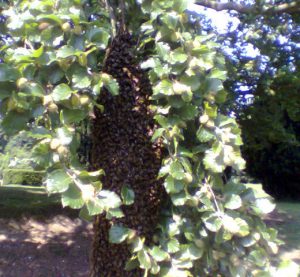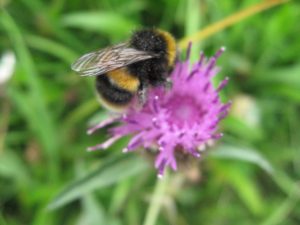Please try to identify what you see:

Honeybee swarm hanging in a tree
If you have found a clump or ball of bees hanging from a branch/bush or other object it is most likely to be a swarm of honeybees.
Orpington Area Swarm Line
The swarm line is open between the 7th April and 15th July each year which is the active season for honey bee swarms. We try to answer calls between 9am to 7pm each day during this period.
Telephone No: 07743 914140
You will be given contact details of a local beekeeper who will collect it if possible.
Please be ready to give the following details: approximate height of swarm, approximate size (e.g. Tennis Ball, Grapefruit, Rugby Ball?), how long it may have been there, the location address, any access restrictions, and your name and telephone number). A small charge may be payable.
No clump or ball of bees?
If on the other hand there is no obvious clump of bees and instead you see and are concerned about bees entering and exiting your roof space, e.g. through the soffits or the eaves of your house, or a hole in a wall, a bird nest box or a compost heap, please have a good look at them (binoculars can be useful). It is essential to identify what you have before going to the possible expense of any further action.
If you are not confident in your identification of what you see (honeybees, bumblebees, solitary bees or wasps) please send a photo of one to 07743 914140 and we will do our best to advise.
Bumblebees
Bumblebees are generally fat and furry and their size can vary from quite small to the familiar large black and yellow, loudly buzzing bees that visit our garden flowers. Some bumblebee species commonly nest in roof spaces, nest boxes and compost heaps. Bumblebees are harmless if their flight path does not interfere with people and their nests can be left undisturbed.

Bumble Bee
The nest and the bees will die away in a few weeks and in most cases it is far better for the bees and your pocket to leave them to live out their short life cycle.
Bumblebees are extremely important pollinators, most are docile and the workers would only sting if handled roughly or their nest interfered with. In some cases it may be possible to move bumblebee nests but as this always weakens the bumblebee colony we only do this in exceptional circumstances.
In 2014 approximately 8 out of every 10 calls we received concerned Tree Bumblebees nests (Bombus hypnorum) rather than Honeybee swarms. Tree Bumblebees are now commonly found nesting in loft spaces, bird boxes and trees in gardens in much of England.
Tree Bumblebees are easy to identify: mostly black with red/brown- orange thorax and a white to buff tail. [please insert a photo here]. Many people observed 10-20 bees hovering around outside the holes that other similar bees were entering and exiting from. Most of these were Tree Bumblebee nests which had reached the mature stage of producing new queens.
The presence and activity of the bees had usually not been noticed until the hovering behaviour was observed. The hovering bees are drones (males) that have detected the pheromones of the new queens in the nest and hope to mate with them. After mating the new queens leave the nest to hibernate elsewhere, while the drones, the workers and the old queen die.
Some people find the sight of the hovering bees alarming and assume they have a swarm, though in fact, the hovering drones have no sting, and bumblebees do not swarm.
See the Bumblebee Conservation Trust and the Natural History Museum Bumblebee interactive identification guide….
Wasps
Some species of social wasps also commonly nest in roof spaces, sheds, garages, bushes and gardens. Social wasps are important predators of aphids and other garden pests and their nests nearly always die out by the autumn, if not before. If their flight path to and from the nest and the nest location itself does not restrict or threaten your safety in any way it would be ecologically and financially better to let them live out their life cycle.
Old wasp nests are not reoccupied in following years, though dark and dry loft spaces can be selected by new overwintering queens. If your loft regularly houses wasp nests this would be because it offers queens which have survived the winter easy access and a desirable environment to nest in! The only way to stop them doing so again would be to block or restrict all the possible access points – new insulating sheet under tiles, and new insect proof soffits. This is probably impractical in most cases as wasps (and bees) only require a space of 8mm to enter a cavity that meets their nesting requirements.
What is a Honeybee Swarm?
Honeybees swarm as a means of reproduction. The old queen produces eggs which the worker bees rear into new queens. If the conditions are right the old queen will leave the nest with a large proportion of the flying bees. The swarm will land in one or more places temporarily while scout bees from the swarm try to locate a suitable nesting site.
Before setting off the bees in the swarm will have taken on stores of honey to help them set up their new home and will be intent on sticking together in a well fed group until the scout bees flying around have found them a new home. The swarm is usually docile and uninterested in humans at this stage so if you leave them alone they will leave you alone. If the swarm is reachable it can usually be collected by a beekeeper.
If you see a swarm of honeybees entering a hole in your house or shed and it is lower than 15 feet we may be able to advise. Please note, however, that each situation is different and that removing a swarm that has established a nest (i.e. within a few days of arriving) is much more difficult and costly.
Honeybees in chimneys
Honeybee swarms occasionally enter such locations and establish nests. Unless you are planning roof works with appropriate scaffolding, we will not be able to help with their removal. PGH Pest Control www.pghpestcontrol.co.uk offer a service which may suit this circumstance. Please note that this contact is provided for information only as we have no direct experience of their service.
